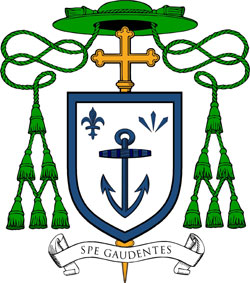Heraldic Achievement of
MOST REVEREND JOHN J. MCINTYRE
Titular Bishop of Bononia
Auxiliary to the Archbishop of Philadelphia

Argent, an anchor, in dexter chief a fleur-de-lis and in sinister chief three Passion nails closing toward the points azure, within a bordure of the last.
In designing the shield—the central element in what is formally called the heraldic achievement—a bishop has an opportunity to depict symbolically various aspects of his own life and heritage, and particular aspects of Catholic faith and devotion. The formal description of a coat of arms, known as the blazon, uses a technical language, derived from medieval French and English terms, which allows the appearance and position of each element in the achievement to be recorded precisely.
The colors—called tinctures—that Bishop McIntyre has chosen for his coat of arms allude to the arms of the Archdiocese of Philadelphia, where the primary tinctures are also silver (argent) and blue (azure). Bishop McIntyre was born and raised in Philadelphia, and has served the Archdiocese as a priest since 1992.
The primary object or charge depicted on the shield is an anchor. Since the earliest days of the Church the anchor has been a symbol of the theological virtue of hope; the Letter to the Hebrews refers to “the hope that lies before us” as “an anchor of the soul” (6:18–19). Anchors are frequently depicted on epitaphs in the Roman catacombs, and one famous example from the cemetery of Saint Domitilla dates from the end of the first century. In heraldry, as in the catacombs, the anchor is most often depicted with a prominent cross-beam below the ring. During times of persecution this combination of cross and anchor enabled Christians to portray the Cross of Christ in a hidden way, and this two-fold symbol stands as a reminder that it is through Christ crucified that we are “saved in hope” (spe salvi: Romans 8:24). In light of this gift of salvation, Saint Paul calls upon Christians also to “rejoice in hope, endure in affliction, [and] persevere in prayer” (Romans 12:12), and the first two words of this verse serve as the Bishop’s motto, which appears on the scroll below the shield.
Another reminder of the Passion and death of the Lord is the arrangement of three nails in the top right corner (sinister chief) of the shield. Their particular shape and number identify them as Passion nails, representing those that pierced the hands and feet of the Lord Jesus. Most dear among the relics of the crucifixion, the nails here allude to the Congregation of the Most Holy Redeemer (the Redemptorists), in whose seminaries Bishop McIntyre studied as a young man. Moreover, the Bishop’s surname, from the Gaelic Mac an t-Saoir, is traditionally interpreted to mean “son of the carpenter (saor)”. The nails, chief among a carpenter’s tools, thus allude both to the Bishop’s family, as well as to the “carpenter’s son” (Matthew 13:55) who accepted the nails of the Cross in order to carry out the work of our Redemption.
The shield is also charged with a fleur-de-lis, a stylized lily that has long been used in heraldic and ecclesiastical symbolism to represent the Blessed Virgin Mary (cf. Song of Songs 2:1). The description of the lily’s location in dexter chief means that it is at the top of the side of the shield to the viewer’s left, which would cover the right side (in Latin, dextera) of the person carrying the shield.
The charges on the shield are surrounded by a blue (azure) border, and the shield itself is ensigned with external elements that identify the bearer as a bishop. A gold processional cross appears behind the shield. The galero or “pilgrim’s hat” is used heraldically in various colors and with specific numbers of tassels to indicate the rank of a bearer of a coat of arms. A bishop uses a green galero with three rows of green tassels.